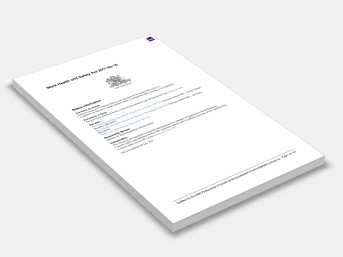Work Health and Safety Act 2011 No 10 (NSW)
NSW Government
NSW LEGISLATION.
The main object of this Act is to provide for a balanced and nationally consistent framework to secure the health and safety of workers and workplaces by—
(a) protecting workers and other persons against harm to their health, safety and welfare through the elimination or minimisation of risks arising from work or from specified types of substances or plant, and
(b) providing for fair and effective workplace representation, consultation, co-operation and issue resolution in relation to work health and safety, and
(c) encouraging unions and employer organisations to take a constructive role in promoting improvements in work health and safety practices, and assisting persons conducting businesses or undertakings and workers to achieve a healthier and safer working environment, and
(d) promoting the provision of advice, information, education and training in relation to work health and safety, and
(e) securing compliance with this Act through effective and appropriate compliance and enforcement measures, and
(f) ensuring appropriate scrutiny and review of actions taken by persons exercising powers and performing functions under this Act, and
(g) providing a framework for continuous improvement and progressively higher standards of work health and safety, and
(h) maintaining and strengthening the national harmonisation of laws relating to work health and safety and to facilitate a consistent national approach to work health and safety in this jurisdiction.
In furthering subsection (1) (a), regard must be had to the principle that workers and other persons should be given the highest level of protection against harm to their health, safety and welfare from hazards and risks arising from work or from specified types of substances or plant as is reasonably practicable.
Contents:
Long title
Part 1: Preliminary
Division 1: Introduction
Division 2: Object
Division 3: Interpretation
Subdivision 1: Definitions
Subdivision 2: Other important terms
Division 4: Application of Act
Part 2: Health and safety duties
Division 1: Introductory
Subdivision 1: Principles that apply to duties
Subdivision 2: What is reasonably
Division 2: Primary duty of care
Division 3: Further duties of persons conducting businesses or undertakings
Division 4: Duty of officers, workers and other persons
Division 5: Offences and penalties
Part 3: Incident notification
Part 4: Authorisations
Part 5: Consultation, representation and participation
Division 1: Consultation, co-operation and co-ordination between duty holders
Division 2: Consultation with workers
Division 3: Health and safety representatives
Subdivision 1: Request for election of health and safety representatives
Subdivision 2: Determination of work groups
Subdivision 3: Multiple-business work groups
Subdivision 4: Election of health and safety representatives
Subdivision 5: Powers and functions of health and safety representatives
Subdivision 6: Obligations of person conducting business or undertaking to health and safety representatives
Division 4: Health and safety committees
Division 5: Issue resolution
Division 6: Right to cease or direct cessation of unsafe work
Division 7: Provisional improvement notices
Division 8: Part not to apply to prisoners
Part 6: Discriminatory, coercive and misleading conduct
Division 1: Prohibition of discriminatory, coercive or misleading conduct
Division 2: Criminal proceedings in relation to discriminatory conduct
Division 3: Civil proceedings in relation to discriminatory or coercive conduct
Division 4: General
Part 7: Workplace entry by WHS entry permit holders
Division 1: Introductory
Division 2: Entry to inquire into suspected contraventions
Division 3: Entry to consult and advise
Division 4: Requirements for WHS entry permit holders
Division 5: WHS entry permits
Division 6: Dealing with disputes
Division 7: Prohibitions
Division 8: General
Part 8: The regulator
Division 1: Functions of regulator
Division 2: Powers of regulator to obtain information
Part 9: Securing compliance
Division 1: Appointment of inspectors
Division 2: Functions and powers of inspectors
Division 3: Powers relating to entry
Subdivision 1: General powers of entry
Subdivision 2: Search warrants
Subdivision 3: Limitation on entry powers
Subdivision 4: Specific powers on entry
Division 4: Damage and compensation
Division 5: Other matters
Division 6: Offences in relation to inspectors
Part 10: Enforcement measures
Division 1: Improvement notice
Division 2: Prohibition notices
Division 3: Non-disturbance notices
Division 4: General requirements applying to notices
Division 5: Remedial action
Division 6: Injunctions
Part 11: Enforceable undertakings
Part 12: Review of decisions
Division 1: Reviewable decisions
Division 2: Internal review
Division 3: External review
Part 13: Legal proceedings
Division 1: General matters
Division 2: Sentencing for offences
Division 2A: Penalty units
Division 3: Penalty notices
Division 4: Offences by bodies corporate
Division 5: The Crown
Division 6: Public authorities
Division 7: WHS civil penalty provisions
Division 8:Civil liability not affected by this Act
Part 14: General
Division 1: General provisions
Division 2: Codes of practice
Division 3: Regulation-making powers
Division 3A: Miscellaneous
Schedule 1: Application of Act to dangerous goods and high risk plant
Schedule 2: The regulator
Schedule 3: Regulation-making power
Schedule 4: Savings, transitional and other provisions
Schedule 5: Provisions transferred by the Fair Trading Legislation Amendment (Miscellaneous) Act 2018
Historical notes
